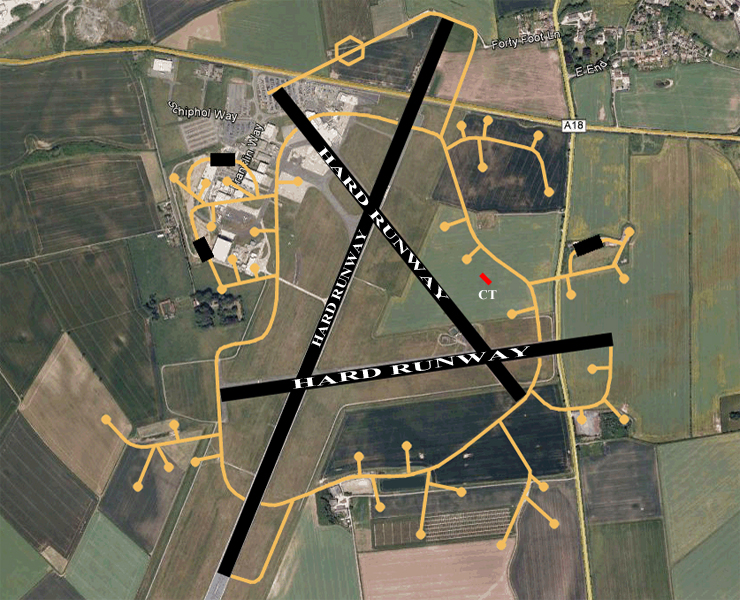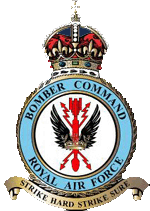Kirmington Airfield History

(Map edited to show the airfield and runways 1940-45)

© Crown Copyright/MOD 2010
53°34'40.5"N 0°20'45.5"WRunways:
09/27 & 14/32 4200ft x 150ft - 04/22 6000ft x 150ft
Located directly SW of the village itself, work commenced on the airfield in early 1941. The airfield was built to the standard at the time consisting of three concrete runways. During construction it was decided to extend the runways which in turn lead to the closure of both the A18 to the west of Kirmington, and a minor road running to the north of the village. The total area used for the entire airfield covered some 575 acres.
Of the original 36 pan-type hard standings two were, lost by perimeter track and hangar taxiway extensions. When extended the runways lengths were 04-22 at 2000 yards and the others both 1400 yards. Two loop-type standings were added as replacements. A T2 hangar was located on the main technical site between runway heads 22 and 27 and another on the on a maintenance site near Kirmington Villa with another T2 and a B1 to the north. Two blister hangars were erected on pan hard standings adjacent to the technical site T2. The bomb store was off the south side of the airfield with eleven camp sites (of which seven were domestic), were dispersed around Kirmington village itself and further to the east, allowing for 2177 males and 345 females.
By January 1942 the airfield was complete and immediately placed under the command of 1 Group, Bomber Command.
Initially the airfield was loaned out to 21 Group Flying Training Command, and with this 15 (P) AFU moved in on the 19th February operating their Avro Ansons and Airspeed Oxfords. Their stay was to be short though, and on 23rd October 1942 they moved on and the airfield was transferred back to Bomber Command. Soon after the transfer, the first of the big hitting Bomber Command squadrons arrived in the shape of No.150 Squadron in October 1942. With them came the Vickers Wellingtons bomber, but again, this squadrons stay was also to be short lived. During December, twelve aircraft were to leave the squadron, heading for North Africa. At the same time, No.142 Squadron at RAF Grimsby was having the same done to them, leaving both squadrons very thin on the ground. With this, the remainder of No.142 Squadron were moved to Kirmington, to make way for a new squadron there.
.gif)
© Unknown - Ground Crew 'A' Flight, No.166 Sqn - 1943
With the thinning out of both squadrons, the decision was taken to merge the two to form a new, full strength squadron at Kirmington. So on 27th January 1943, No.150 and No.142 Squadrons were both disbanded and merged to form No.166 Squadron operating the Wellington. The newly formed squadron didn’t have to wait long to make their operational debut. Only hours after being formed they were tasked with mine laying operations in enemy waters and seven aircraft were sent. Their first bombing mission was to follow a few nights later, when twelve aircraft were tasked with a bombing raid on Lorient.
No.166 squadron continued to operate the Wellington until September 1943, when they acquired the newly released Lancasters from No.100 Squadron. Their transition to the Lancaster was short, and on the 22nd of the same month they were used for the first time as a two-flight unit. The squadron continued to operate like this until the 7th November when a third flight was formed.
With the turn of the year came another control change of the airfield when in January 1944, the station became a sub-station of 13 Base, which had already formed its headquarters at near-by Elsham Wolds. The 7th October 1944, bought more change for No.166 squadron, when ‘C’ flight was detached to help provide the reformation of No.153 Sqn at the airfield. Their stay was very short lived and two weeks later on the 14th, the newly formed squadron left the station for its new home at RAF Scampton. But No.166 squadron was soon to be back at full strength again when on 7th October 1944, the newly formed ‘C’ flight joined them from RAF Faldingworth.
.gif)
© IWM - No 166 Sqn, ED731 - 1943
No.166 squadron remained at the station for the remainder of the war and during that time took part in most of the major raids, along with also playing a major part in mine lying operations. The squadron flew their last operational mission on 25th April 1945, when twenty five Lancasters were tasked with bombing the SS barracks at Berchtesgaden, but only twenty four were to make the mission. This was soon followed by their last mission of any sort during the war, when they were tasked with a supplies drop over Holland on 7th May 1945.
By the end of the war No.166 Sqn had four Lancasters which had completed 100 operations, but only one of them had completed the 100 in its entirety solely with the squadron. Lancaster ME746 known as ‘Roger Squared’ made its operational debut on the night of 20th / 21st April 1944 as part of a raid on Cologne, and by March the following year had completed its 100th operational mission as part of a raid on Kassel. By the time the war had finished the aircraft had been credited with a total of 124 operational sorties.
During operations from the airfield a total of 178 aircraft failed to return. This being made up of 127 Lancasters and 51 Wellingtons.
With the war now over, No.166 Sqn continued non-operational flying until it was eventually disbanded on the 18th November 1945. The disbandment of the squadron was marked with a ceremony at RAF Elsham Wolds on the same date. The disbandment was shortly followed by the disbandment of No.13 Base and with this; control of the airfield was passed to RAF Hemswell on 15th December 1945.
With no more flying units at the station its future looked bleak, and it was finally placed on Care and Maintenance on 15th December 1945. As with many other airfields at the close of the war, the station became a sub-site for a maintenance unit, in this case it was 35 MU. A large hutted camp was then erected on one of the runways during early 1946. The camp was to be used for holding military disposal sales for the Air Ministry, and during 1946 and 1947 several were held.
Eventually the entire airfield was transferred to the Ministry of Agriculture in 1953, and all the land between the runways were returned to farming once again.
With control of the airfield now in civilian hands, very little use was made of the remaining runways, only the occasional visit by crop spraying aircraft. This continued until August 1967 when Air Links Chauffeurs started to fly Cessna aircraft from part of the disused runway. Then in February 1968 the company changed its operating name to Humber Airways and slowly started to expand its operations from the airfield.
.gif)
© BCAR - View down former runway 2012
In 1970 Kirmington was selected as the best location for a regional airport serving the Hull, Grimsby and Scunthorpe localities. By this time the A18 had been restored and took in part of the northern end of runway 22, but the others were in good order although a minor road had been reopened across the flying field. In furtherance of the project, the airfield was purchased by Lindsey County Council for a reported £85,000, a further £170,000 being invested in refurbishing the runways, building a new terminal and control tower. Kirmington Airport was formally opened on the 26th March 1974, but its name was to change again the following month to Humberside Airport, after control was passed to the newly formed Humberside County Council.
The first major company to make use of the new facilities at the airport was to be Lease Air Ltd which formed in April 1972. The company were to provide the majority of the ground facilities along with operating its own fleet of Cessna aircraft. Over the coming years both the airport and Lease Air Ltd itself began to expand its operations, by taking on work for local companies. This led to the first Dakota for Eastern Airways arriving at the airfield on the 17th July 1978. This aircraft was joined by a further two Dakotas the following year and all were to be used for night mail flights all over the country.
Many more civil aviation companies were to use the facilities at the airport over the coming years, and with the opening of the Humber Bridge on 24th June 1981, bringing more people within its catchment area. Today, Humberside is a thriving modern airport servicing the needs of not only local people and companies, but the needs of a growing number of European ones too, although the airport has since been acquired by Manchester Airport PLC.
Very little original WWII remains can be found, the airfield itself has been extended and modified, a few dispersed buildings can be found in Kirmington village and evidence of others can be found in the woodland. A fine memorial can be found in Kirmington village close to the church.
| Date | Squadron | Notes |
|---|---|---|
| January 1942 | Station opened. | |
| February 1942 | No.15 (P) AFU | The Advanced Flying Unit operated the Avro Anson and Airspeed Oxford. They left the station on 23rd October 1942. |
| October 1942 | No.150 Sqn | They operated the Vickers Wellington. The squadron was disbanded at the airfield on the 27th January 1943. |
| December 1942 | No.142 Sqn | Operated the Vickers Wellington. The squadron was disbanded at the airfield on 27th January 1943. |
| January 1943 | No.166 Sqn | The squadron operated the Vickers Wellington and Avro Lancaster. The squadron was disbanded at the station on the 18th November 1945. |
| October 1944 | No.153 Sqn | The squadron operated the Avro Lancaster. They left the airfield on the 14th October 1944. |
| December 1945 | Station placed on Care and Maintenance. | |
| 1953 | Station closed and transferred to the Ministry of Agriculture. |
